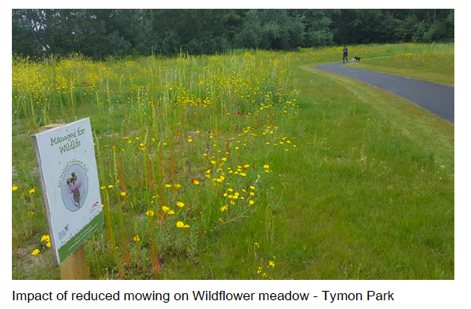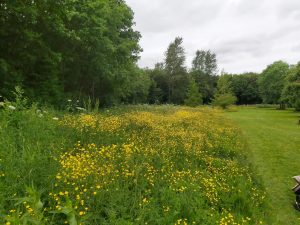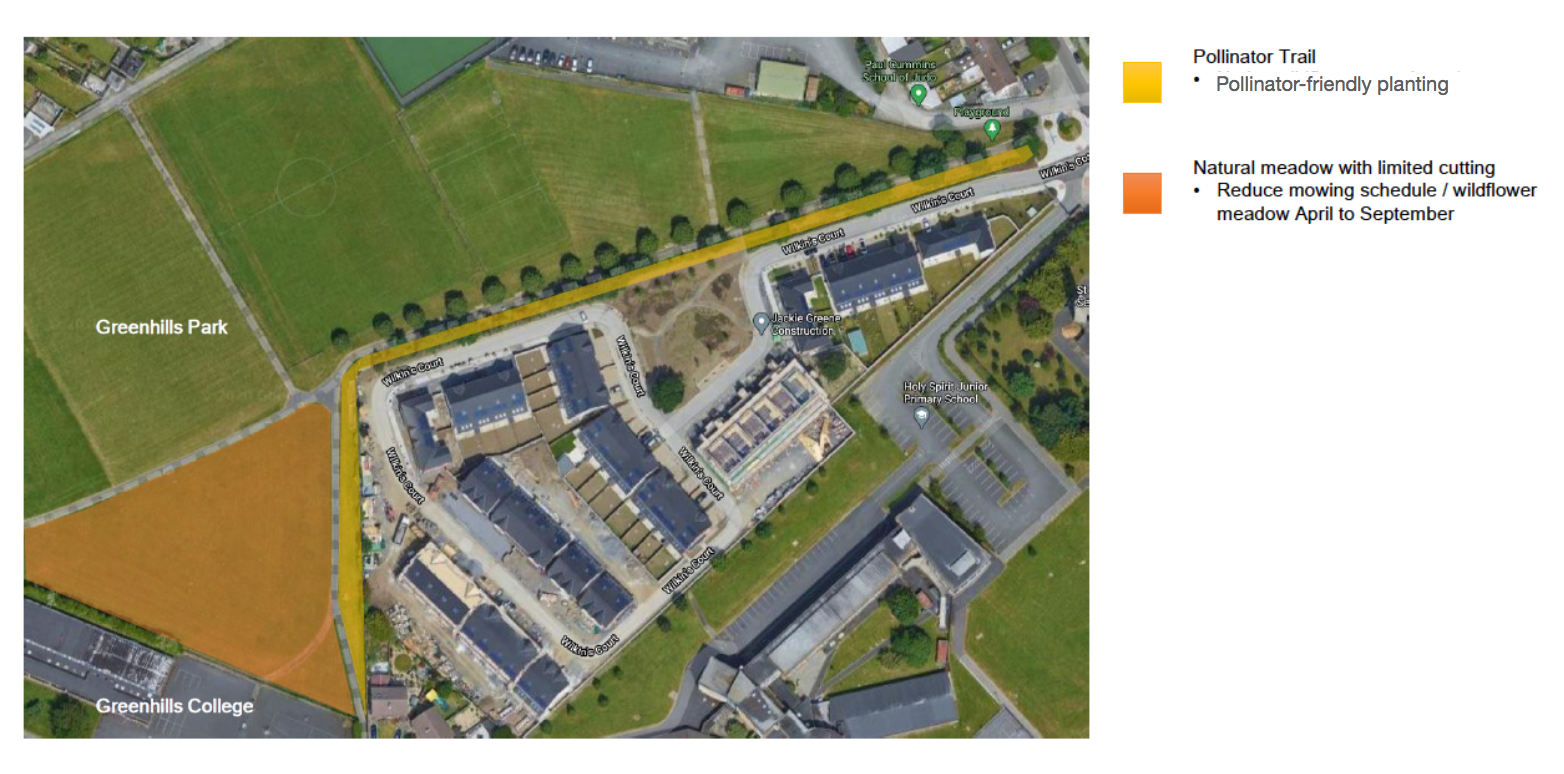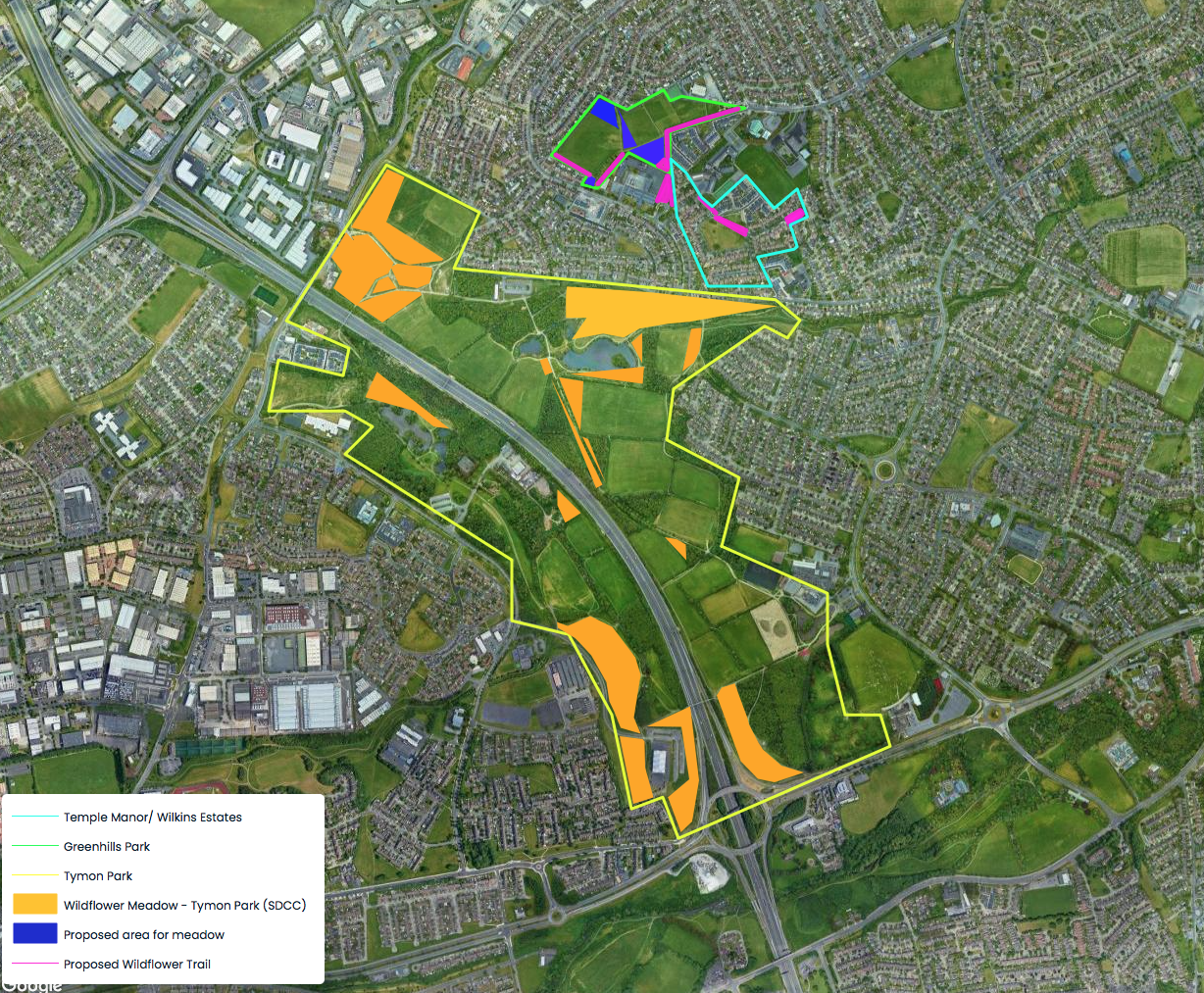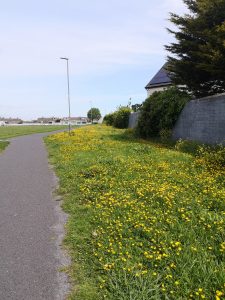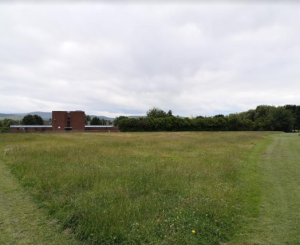Temple Manor/Wilkins Residents’ Association (TMWRAC) explain the Biodiversity Plan they have created for Greenhills, Dublin 12
Temple Manor Residents’ Association was set up some seven years ago and since then has expanded to take into account the recently completed development of Wilkins View, to form the expanded Temple Manor/ Wilkins Residents Association (TMWRAC) now representing approximately 275 households in Dublin 12.
We consider ourselves lucky in that that we have an incredibly active group of residents who are generous with their time in maintaining and enhancing the area for the benefit of all. TMWRAC have, for a number of years, organised regular clean-ups of the area and engage in grass-cutting in areas not covered by South Dublin County Council (SDCC) services. We have also installed planting schemes at the estate entrance and at road signs throughout the estate. Our regular clean-ups involve necessary pruning of bushes and plants, replanting of shrubs, and ongoing litter removal.
INTRODUCTION
It is clear that the community has become more aware of, and educated, about biodiversity and its importance in our ever-changing environment as we now look at public spaces through a new lens, particularly given our experiences over the past 18 months. Our plan is informed by the All-Ireland Pollinator Plan, the SDCC Biodiversity Plan (2020-2026) and is inspired by the great work undertaken SDCC in Tymon Park, which won an award in the Green Flag for Parks Pollinator Awards, administered by An Taisce, in 2019, which you can read about here: https://pollinators.ie/making-meadows-in-south-dublin/
There has been an incredibly positive response to these pollinator actions undertaken by SDCC, and it has greatly enhanced the public’s enjoyment of this amenity. We are also mindful that national government has declared a Biodiversity Emergency in this regard and that urgent changes need to be made to our environment to halt this decline in biodiversity.
There has been an incredibly positive response to
these pollinator actions undertaken by SDCC,
and it has greatly enhanced the public’s enjoyment of this amenity.
Tymon Park © Codie Cory
OUR PROPOSAL
Accordingly, our aim was to nurture this inspiration and awareness so that we could have a further positive impact on biodiversity. We want to expand the reach of the great work done by SDCC in Tymon Park and create important ‘stepping stones’ for pollinators in our community by identifying areas where biodiversity initiatives could be put in place, with Greenhills Park as the focal point for these initiatives. To this end, TMWRAC prepared a proposal for SDCC in February 2021 after significant consultation with the local community.
Overview
Greenhills Park is a pocket park of c.16 acres situated in Dublin 12. It is a popular park, with multiple uses, and is enjoyed by the community in the following areas:
- Bangor GG FC playing pitches
- Playground
- Exercise/outdoor gym equipment
- Walking and dog-walkers
However, there are many areas in these public spaces that are under-utilised by the public at present and, in some instances, are prone to anti-social behaviour (dumping, bonfires, etc.). We identified these areas as ideal spaces where a number of initiatives could be implemented to make better use of this land and to enhance the biodiversity of these areas.
The area around the Temple Manor/Wilkins View Estate also has a lot of under-utilised green space, which is ideal for a number of biodiversity actions.
Objectives
The main objectives of our proposal were to support and build on national and local policies and best practice, by progressing a number of strategies to improve biodiversity measures across the county, namely:
- To implement, in particular, pollinator-friendly biodiversity practices at local and community level
- To increase neighbourhood/community awareness and knowledge of our biodiversity and to foster direct engagement with the creation and maintenance of specific biodiversity actions
- To create a Pollinator Trail and provide the opportunity for local households to plant pollinator-friendly flora as part of this trail
- To provide educational opportunities for children on our biodiversity and the need to protect and assist our pollinators. This element can be undertaken in conjunction with local schools
Actions
In putting our proposal together, we considered what was possible in terms of liaising with the residents and stakeholders to see what they would be comfortable with in terms of initiatives and their reach, as this can be the greatest barrier to adaptation, but also best practice as issued by the All-Ireland Pollinator Plan for Local Communities.
TMWRAC proposed the following actions for the areas identified in the maps below, which we hoped would have a positive impact on biodiversity, with minimal impact on the public’s enjoyment of these under-utilised spaces:
- Reduce mowing from April to September to create wildflower meadows
- Creation of a Pollinator Trail through the community
- Appropriate planting of native and pollinator-friendly trees and plants subject to appropriate guidance/permission from SDCC.
- Provide biodiversity education opportunities and direct stakeholder engagement of householders and their children.
By looking at their area maps, TMWRAC were able to pinpoint appropriate areas for reduced mowing and pollinator-friendly planting.
We proposed a Pollinator Trail, which would start at the entrance to Greenhills Park and continue along the perimeter of the park and into the public spaces within the Temple Manor/ Wilkins View estate. This would involve creating a low-mow meadow area across the green in the Temple Manor estate, ending at an under-utilised green space at the end of Temple Manor Way. In terms of the under-utilised green at the end of Temple Manor Way, TMWRAC envisaged that this under-used space will provide an opportunity for significant development for biodiversity. The perimeter wall surrounding the green provides the opportunity for appropriate native hedgerow planting (Willow, Hawthorn, Blackthorn, etc.), the possibility of creating a small apple orchard, pollinator-friendly bed, and wild meadow areas, producing a layered effect over the area.
Residents would also be encouraged to get involved in appropriate planting and other activities to fill the gaps between the public space areas.
©Scribble Maps
Our proposal to SDCC is ambitious. It is ambitious by design as we hope to start a discussion on how a community-led project, working with the Council, could become a blueprint or flagship project for biodiversity within an urban estate. We firmly believe that is a worthwhile pilot project and one that could inform future developments across the county.
‘we hope to start a discussion on how a community-led project,
working with the Council, could become a blueprint or flagship project
for biodiversity within an urban estate.’
COMMUNITY INVOLVEMENT & SUSTAINABILITY
TMWRAC hope to incorporate and integrate biodiversity activities in clean-ups, maintenance and annual family events, placing emphasis on the engagement of children and younger members of the community, e.g. construction of bee, butterfly and insect hotels, mini-beast hunts, bee-spotting walks, etc. Householders will also be encouraged to plant pollinator-friendly plants in their gardens to encourage improved biodiversity.
TMWRAC would utilise the resources available from the Pollinator Plan website to provide our residents with the information to put in place their own initiatives and to increase the availability of pollinator-friendly plants within the area.
AWARENESS
The use of appropriate information signage will be key to letting the public know that the area is being ‘managed for pollinators’, and is not simply being neglected. This, along with the actions of TMWRAC, will be key in bringing the community along on this journey to improve the biodiversity of these areas and household gardens.
Awareness of the initiative will also be raised within local schools, who shall be invited to become involved in our activities and will be encouraged to enjoy the environment following the positive impact and outcomes achieved for biodiversity. This will include nature walks, bee-spotting, etc. TMWRAC has already undertaken local nature walks in Tymon Park with younger residents. Both local schools may consider a number of initiatives in their own grounds on the back of the positivity of our project.
LIMITATIONS
We were mindful when putting the proposal together that there are constraints at the local authority level, be they financial or operational, in terms of the manpower/necessary equipment available (e.g. for grass collection), or a combination of both. Whilst a number of initiatives are worthy in terms of their goal, they also may present SDCC and their public realm department with a new set of challenges. This has meant that some actions are easier to roll out than others.
In terms of reduced mowing regimes, we found it is easier for local authorities to agree to large spaces to be adapted to reduced mowing for meadowlands, as it is easier for the grass to be lifted by large machines come September. Smaller areas are prohibitive given that many authorities do not possess the equipment to lift this grass to deplete the nitrogen in the soil and/or do not lift grass as a work practice. This somewhat limits the areas that we could ultimately divert for pollinator-friendly initiatives and might be something that other residents groups should consider when putting a plan together for their area.
PROGRESS
As mentioned above, SDCC have agreed to a reduced mowing regime in Greenhills Park, along what is part of the Pollinator Trail (image on left below) and an area has been subjected to reduced mowing allowing for wildflower meadow to thrive during the Summer months for pollinators (image on right below).
Left: Part of the Pollinator Trail in Greenhills Park. Right: Long-flowering/annual meadow developed in Greenhills Park
Whilst this has been a welcome start to the project, we continue to work with SDCC in terms of progressing a number of other measures; to improve signage in the area to promote the positive work done by SDCC and the benefits of the initiatives put in place for pollinators; and the ongoing management of the various areas.
We are conscious that our proposal is not something that will occur immediately but will be developed over a period of years. We have community buy-in; we have community commitment to undertake any works that we can do; and we have community buy-in to take instruction and direction from the local authority. We believe that our plan has the potential to greatly enhance our enjoyment of our green spaces, and provide essential ‘stepping stones’ for pollinators, and bring us, as a community, closer to nature over time.
– Brian O’Neill, Dermot Stanley and Proinsias Mac Fhlannchadha, Temple Manor/Wilkins Residents’ Association

